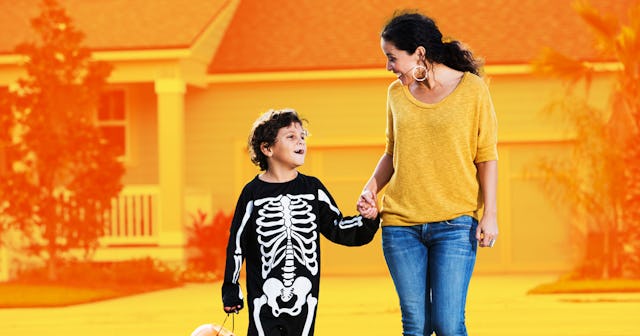Halloween Is The Perfect Opportunity For A Lesson In Cultural Appropriation

Halloween is the one magical day a year when our kids—and adults, too—can pretend to be anything or anyone they want. Maybe your family’s vibe is a superhero theme, something gory, or uber-cheesy. Whatever it is, just don’t let your kids—or yourselves—choose a costume that culturally appropriates. It’s not cute to mock or attempt to (poorly) imitate another person’s culture for your own entertainment. You don’t need to be rude while you grab some fun-size Snickers bars.
I’ve heard it a thousand times. Halloween is fun, so why can’t we all just lighten up on the political correctness? You know, everybody gets offended over everything these days. We should just let kids be kids. It’s just one day a year! Costumes are all in good fun. It’s just no big deal unless someone makes it a big deal.
I acknowledge that cultural appropriation wasn’t a thing when I was a kid. There wasn’t a term for it. During my grade school Halloween parties, there were plenty of kids running around dressed as all sorts of cultures. I went one year as a Hawaiian girl, complete with a grass skirt and a shell necklace. I felt cute, and I had no clue that I was appropriating. However, just because we did something as kids doesn’t mean that it’s OK for our kids to do the same. We know better now. At least, I hope we do.
The point is that a person’s intention—say, to have a good time by securing as much free candy as possible—doesn’t matter, because it’s the impact that counts. If the impact has the possibility of causing harm to someone else, why in the world would someone be a jerk and participate in cultural appropriation? The person from that culture is part of their culture every day. There’s no free pass to infringe upon their culture just because the calendar reads October 31st.
Let’s back up. In case you need a refresher: Cultural appropriation is defined as “the adoption, usually without acknowledgment, of cultural identity markers from subcultures or minority communities into mainstream culture by people with a relatively privileged status.” There’s a lot to unpack here. Essentially, cultural appropriation occurs when a person steals and utilizes “cultural identity markers” from another culture. Usually this is done for entertainment purposes.
An example of cultural appropriation is when a white person decides to wear their hair in cornrows—a traditionally Black hairstyle—and then is praised (or self-praises) for having such a beautiful, trendy, intricate, or innovative hairstyle, while Black people are derided or discriminated against for the same thing. The white person has taken what doesn’t belong to them and used it for personal gain. Usually, as we often see celebrities do, for attention.
AleksandarNakic/Getty
In the case of Halloween, a parent is allowing cultural appropriation when they allow their child to dress as an Indigenous American —with a feather headdress and a tomahawk — for example. We’ve heard for years, but in case you forgot, a culture is not a costume. At least, it shouldn’t be.
Furthermore, I shouldn’t have to say this, but I’m going to. Blackface or brownface is never, ever OK. Don’t do it, don’t ask why, and don’t make excuses. This is a hard no. In 2021, there is absolutely no way you can talk your way around or out of this.
Cultural appropriation awareness isn’t just about what you don’t do. We learned a few years ago that Disney pulled their Maui costume—from ‘Moana’–after it was flagged by consumers for cultural appropriation. Maybe you’ve said no way to letting your kid appropriate, which is great, but have you taught your child why?
Appropriation occurs every day, made especially visible on social media. It’s important to me that my kids learn real history (not whitewashed, patriarchal nonsense) and appreciate other cultures. You see, there’s distinction between cultural appropriation and cultural appreciation. One takes and manipulates, while the latter is about learning and participating in another culture—when invited—respectfully.
Now, there are costumes that are simply in bad taste or offensive, but aren’t cultural appropriation. I think we need to use discretion and good manners when helping our kids choose their costumes. For example, if your kid wants to dress as a doctor or a nurse—cool. But dressing as COVID? No, just no. There’s nothing cute about putting on a costume to be trendy when that costume represents the deaths of hundreds of thousands of people. Likewise, don’t let your kid be Christopher Columbus—because ew—or even something overly political that they have no idea what that person or thing means.
We can let our kids have freedom to choose a fun costume without letting them be jerks. It’s our job to raise them to be aware of others, as well as their own impact. There are thousands of costume options that don’t enforce stereotypes or harm another person—whether you buy or create one yourself. Choose one of those. It’s that simple.
If your kid comes to you wanting to wear a sombrero or a hijab as part of their Halloween costume, don’t just give them a hard no. Tell them why you are saying no. Likewise, a person’s disability, religion, gender, etc. isn’t up for grabs, either.
If your child is begging you to buy a certain costume that just doesn’t sit right with you, don’t spend too much time examining it. Go with your gut. If you get the icky feeling when your child begs you to dress a certain way, say no and show them other options. But again, you also need to teach them what cultural appropriation is and why they shouldn’t partake in it on Halloween–or any other day of the year.
This article was originally published on